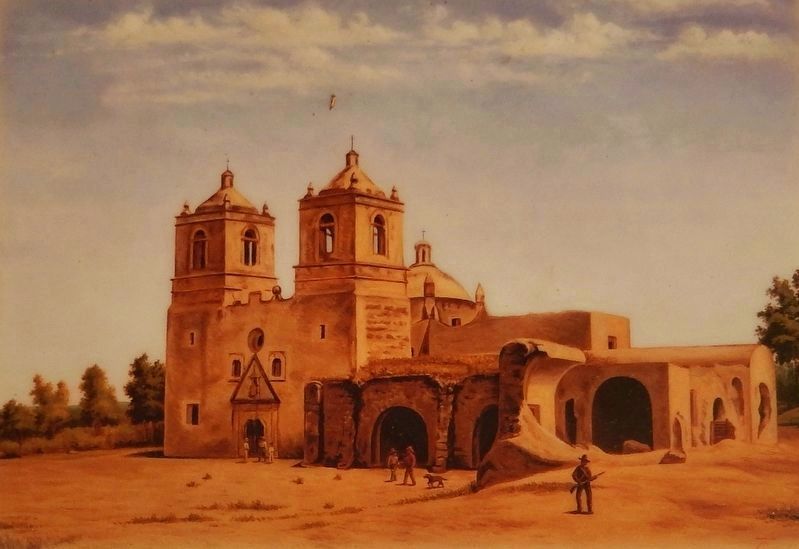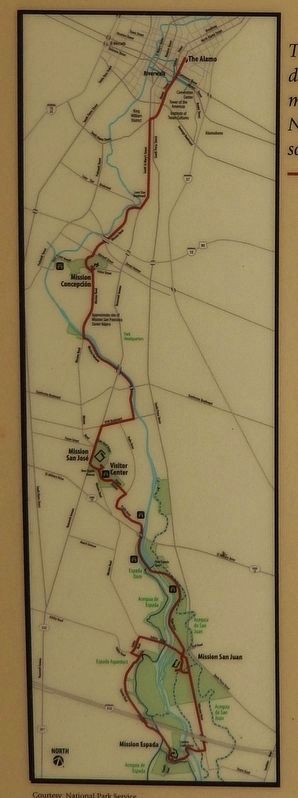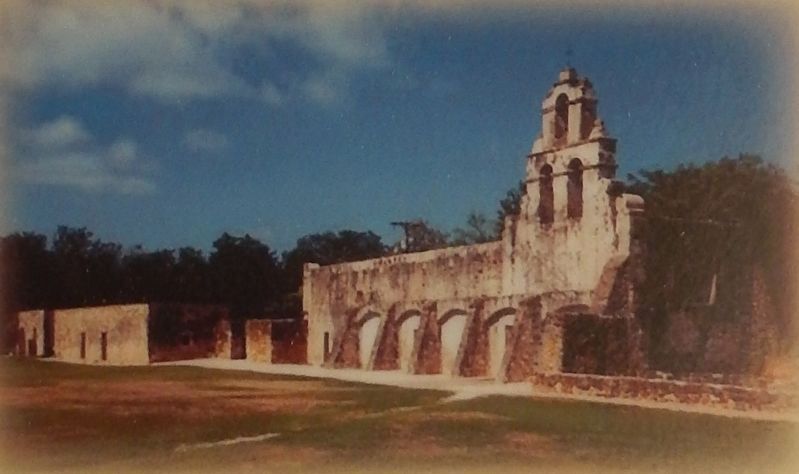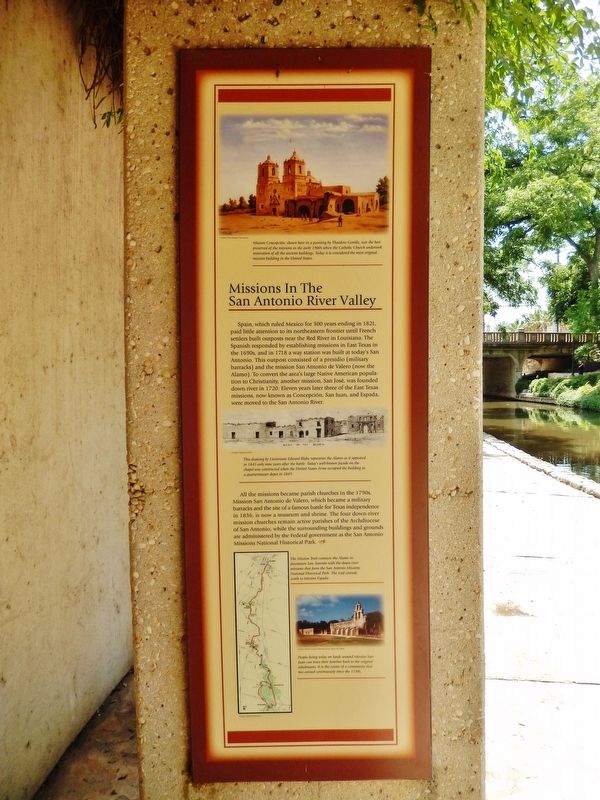Downtown in San Antonio in Bexar County, Texas — The American South (West South Central)
Missions in the San Antonio River Valley
Spain, which ruled Mexico for 300 years ending in 1821, paid little attention to its northeastern frontier until French settlers built outposts near the Red River in Louisiana. The Spanish responded by establishing missions in East Texas in the 1690s, and in 1718 a way station was built at today's San Antonio. This outpost consisted of a presidio (military barracks) and the mission San Antonio de Valero (now the Alamo). To convert the area's large Native American population to Christianity, another mission, San José, was founded down river in 1720. Eleven years later three of the East Texas missions, now known as Concepción, San Juan, and Espada, were moved to the San Antonio River.
All the missions became parish churches in the 1790s. Mission San Antonio de Valero, which became a military barracks and the site of a famous battle for Texas independence in 1836, is now a museum and shrine. The four down-river mission churches remain active parishes of the Archdiocese of San Antonio, while the surrounding buildings and grounds are administered by the Federal government as the San Antonio Missions National Historical Park.
Topics. This historical marker is listed in these topic lists: Churches & Religion • Colonial Era. A significant historical year for this entry is 1718.
Location. 29° 25.905′ N, 98° 29.268′ W. Marker is in San Antonio, Texas, in Bexar County. It is in Downtown. Marker can be reached from Lexington Avenue north of Avenue A, on the right when traveling north. Marker is located on the San Antonio River Walk, on the south side of the river, 1/10 mile east of the Lexington Avenue bridge. Marker is a short walk from the 107 Avenue A parking lot. Touch for map. Marker is at or near this postal address: 107 Avenue A, San Antonio TX 78205, United States of America. Touch for directions.
Other nearby markers. At least 8 other markers are within walking distance of this marker. The San Antonio River (here, next to this marker); The River in the 1900s (here, next to this marker); River Communities (here, next to this marker); The River in the 1800's (here, next to this marker); The Hugman Dam (a few steps from this marker); Mayor Maury Maverick Mural (a few steps from this marker); Toltec Apartments (about 500 feet away, measured in a direct line); Maverick-Carter House (about 600 feet away). Touch for a list and map of all markers in San Antonio.
More about this marker. This marker is one of five adjacent San Antonio River historical markers at this location.
Related markers. Click here for a list of markers that are related to this marker. San Antonio River History
Also see . . .
1. Settling the San Antonio River Valley. In 1718 the first Spanish settlements

Courtesy Witte Museum, San Antonio
2. Marker detail: Mission Concepción
Mission Concepción, shown here in a painting by Theodore Gentilz, was the best preserved of the missions in the early 1900s when the Catholic Church undertook restoration of all the ancient buildings. Today it is considered the most original mission building in the United States.
2. San Antonio Missions National Historical Park. San Antonio Missions National Historical Park is a National Historical Park and part of a UNESCO World Heritage Site preserving four of the five Spanish frontier missions in San Antonio, Texas, USA. These outposts were established by Catholic religious orders to spread Christianity among the local natives. These missions formed part of a colonization system that stretched across the Spanish Southwest in the 17th, 18th, and 19th centuries. In geographic order from north (upstream of the San Antonio River) to south (downstream) the missions are located as follows: Mission Concepción, Mission San Jose, Mission San Juan, and Mission Espada. The Espada Aqueduct, also part of the Park, is due east of Mission San Juan, across the river. (Submitted on June 21, 2018, by Cosmos Mariner of Cape Canaveral, Florida.)

Courtesy: National Archives
3. Marker detail: Alamo as it appeared in 1845
This drawing by Lieutenant Edward Blake represents the Alamo as it appeared in 1845 only nine years after the battle. Today's well-known facade on the chapel was constructed when the United States Army occupied the building as a quartermaster depot in 1849.
3. The San Antonio Missions.
Mission San José
San José y San Miguel de Aguayo, the “Queen of the Missions,” is the largest mission in San Antonio, established in 1720 and completed in 1782.
Mission Concepción
The beautiful church at Mission Nuestra Señora de la Purisima Concepción de Acuña looks much like it did in 1755 when it was first dedicated.
Mission San Juan Capistrano
Mission San Juan was established in San Antonio in 1731. The church, priest’s quarters and granary were completed in 1756. The mission’s fertile farmlands allowed for a self-sustainable community, and its surplus helped supply the region with produce.
Mission Espada
Mission San Francisco de la Espada, the southernmost of the four in the park, contains the best-preserved segment of the acequia (irrigation system) that was used to bring water to the fields. Today, part of the acequia operates the Espada aqueduct and dam. (Submitted on June 21, 2018, by Cosmos Mariner of Cape Canaveral, Florida.)
Credits. This page was last revised on February 2, 2023. It was originally submitted on June 21, 2018, by Cosmos Mariner of Cape Canaveral, Florida. This page has been viewed 469 times since then and 43 times this year. Last updated on July 3, 2018, by Cosmos Mariner of Cape Canaveral, Florida. Photos: 1, 2, 3, 4, 5, 6. submitted on June 21, 2018, by Cosmos Mariner of Cape Canaveral, Florida. • Andrew Ruppenstein was the editor who published this page.



